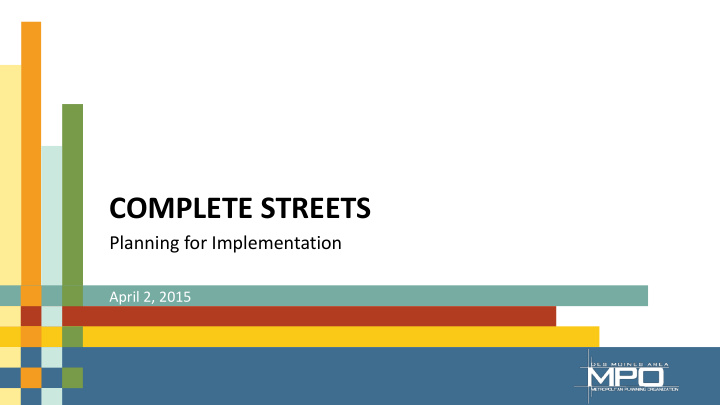



COMPLETE STREETS Planning for Implementation April 2, 2015
Complete Streets Streets that are for everyone. They are designed and operated to enable safe access for all users , whether walking, bicycling, driving or riding transit. People of all ages and abilities are able to safely move along and across streets in a community, regardless of how they are traveling.
US DOT Initiative MAYORS’ CHALLENGE FOR SAFER PEOPLE, SAFER STREETS
Mayors’ Challenge • US DOT Secretary Anthony Foxx challenge to local elected officials to improve bicycle/pedestrian safety • Local Action Activities – Adopt Complete Streets policy – Review street design standards – Improve walking/biking laws and regulations
Mayors’ Challenge: Local Efforts
Complete Streets in Iowa
Benefits of Complete Streets
Incomplete Streets
Planning for Implementation • Designate lead person or agency to oversee implementation • Create broad based committee to oversee process • Write formal implementation plan • Require public annual reports on Complete Streets progress • Conduct inventory of documents for updates to align with policy
Updating Process • Create project-level checklists • Define a process for exemptions • Update or adopt new bicycle, pedestrian, transportation and comprehensive plans that support Complete Streets network • Change project selection criteria • Change maintenance and operations procedures to help ID low-cost projects within existing scope of work
Nashville, TN
Implementation and Process • Bicycle and Pedestrian Advisory Committee • Major Collector and Streets Plan • Project selection, criteria and scoring • Environmental justice
Reviewing and Updating Design Guidance • Writing or rewriting street design guidelines • Choosing existing guidance that reflect national best practices • Updating subdivision and zoning codes • Applying street design guidance to public and private projects
Training and Education • Workshops, webinars and lunch and learns • Community engagement • Use the MPO as a resource
Measuring Performance • Count the number of new or repaired facilities • Track crashes and injuries for all roadway users • Track behavior and use of facilities • Conduct project-level before and after studies • Perform health impact assessments
Cedar Rapids, IA
Design and Measurements • Design Standards as supplement to SUDAS – Takes precedent in conflict • Context sensitive design • Before and after performance data taken by multiple departments
Complete Streets Implementation • Planning for implementation • Updating process • Reviewing and updating design guidelines • Training and education • Measuring performance
Recommend
More recommend